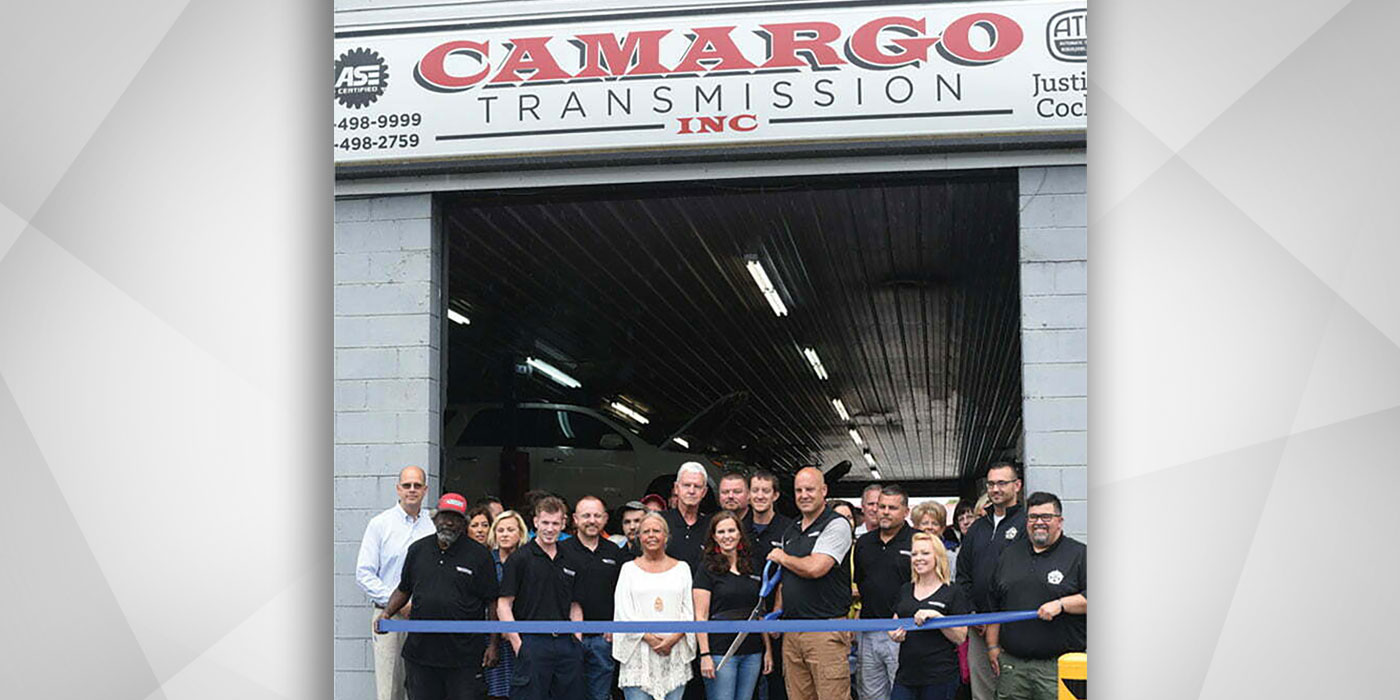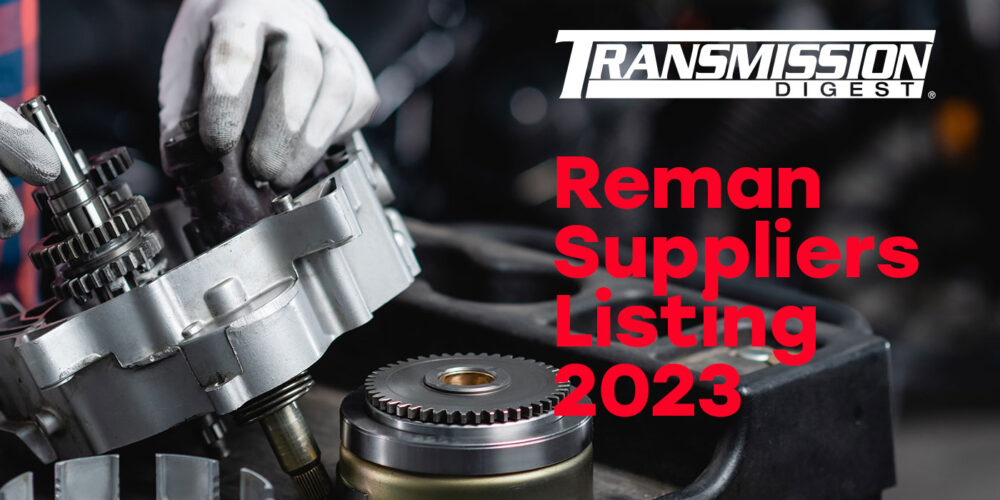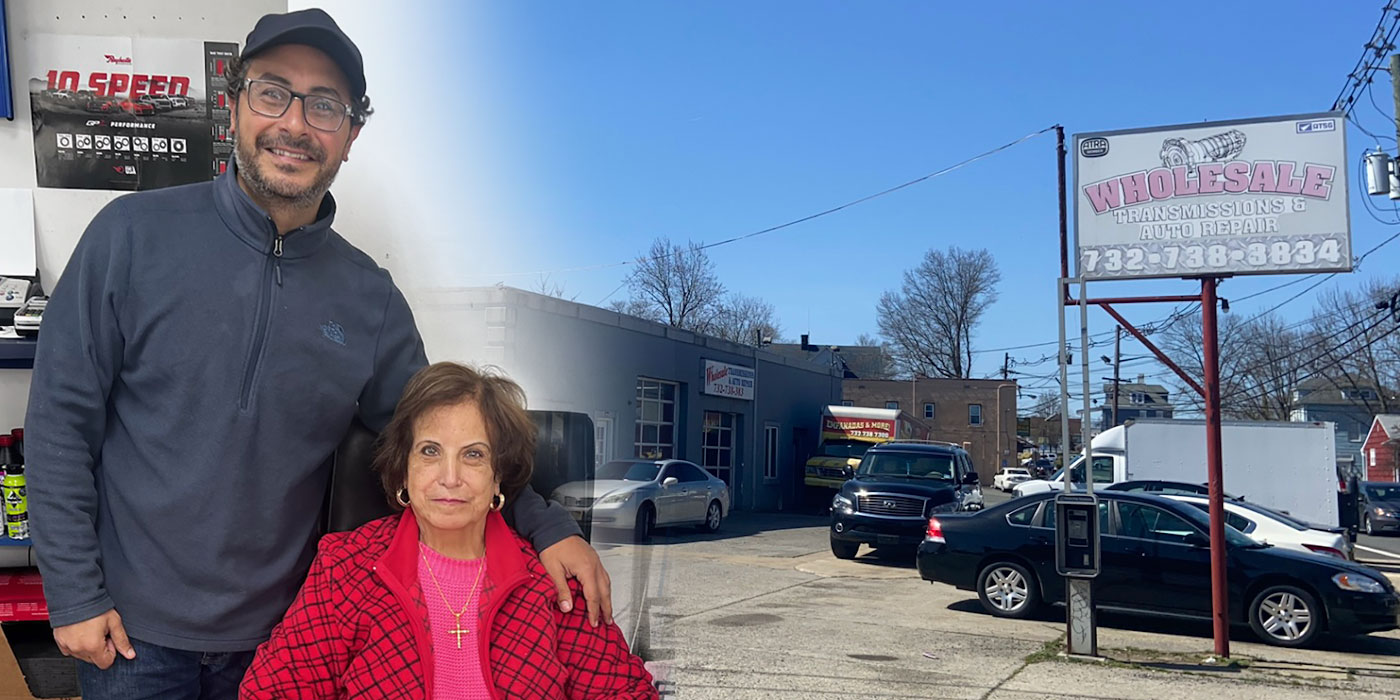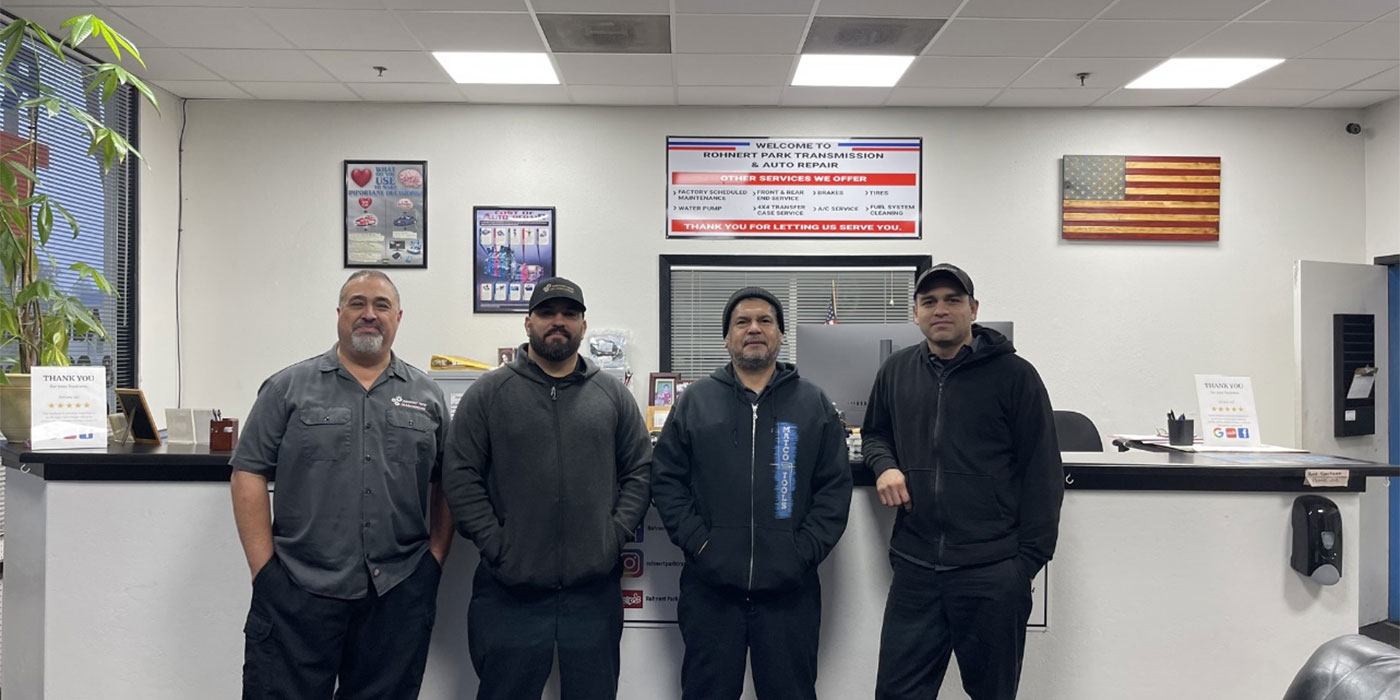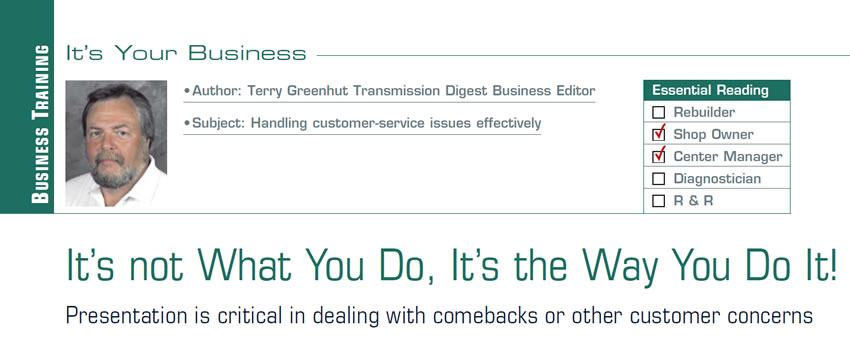
It’s Your Business
- Subject: Handling customer-service issues effectively
- Essential Reading: Shop Owner, Center Manager
- Author: Terry Greenhut, Transmission Digest Business Editor
Presentation is critical in dealing with comebacks or other customer concerns
Good intentions are wonderful, but they are only a concept until they are put into action and properly executed. For example, you may be more than willing to take care of a comeback or other not-so-enjoyable customer situation, but is that what your voice and mannerisms convey to your customers?
No matter what you are willing to do for a customer, it doesn’t mean much if it isn’t properly presented and you, along with your customer, aren’t able to derive some benefit from it. When your customer comes back with a problem or needs you to do a special favor, simply agreeing to take care of it doesn’t give them that warm and fuzzy feeling you’d like them to have. A big smile, a “Thank you for bringing that to my attention,” an offer of alternate transportation, a promise to get it handled right away and properly this time, those are the things that make a difference.
If you’ve ever wondered why some people get so upset when they buy something and have a problem, a documentary I watched the other night pretty much spelled it out. In a word they are “frustrated.” Their worst nightmare is to have to call customer service to get anything resolved. To begin with, many large companies that sell their products in the U.S. and Canada maintain their call centers halfway around the world, and although they hire English-speaking employees it’s not the brand of English that’s easily understood here. In fact, they showed a segment with a teacher training a new group of minimum-wage employees in the fine art of American colloquialisms to try to make the foreign staff sound as though they were here in North America. They even renamed their workers Mike, Tom, Mary and Ann to make them more believable.
Aside from the language barrier we found out that these workers are trained to give only the responses that come up on their computer screens, which often are not relevant to the customer’s problem. The show also mentioned that some companies seem to have phone systems that just keep taking callers in a never-ending circle, hoping they will give up after a while – and many of them do.
With so much of that nonsense going on you can see why some of your customers give you such a hard time. It isn’t you. It’s all the others who came before you, but it means that you have to work harder than ever to gain and keep a customer’s trust. Being honest and happy to help while actually finding a resolution to their problem is what they really want, and it’s what will set you apart from all the others.
None of the above means you have to lose your shirt while being nice to a customer. Often there are ways to make money in these situations. Comebacks give you a chance to get the vehicle back on a lift, an opportunity to sell that brake job you were afraid would possibly screw up your transmission sale, or the drive axles or tune-up the customer did not want to go for while he was laying out $3,000 for a rebuilt transmission. He may go for these things now, but not if you don’t portray yourself as a happy and willing representative of your company.

I know that sinking feeling you get when you pull up to your shop and see a car in the driveway that you know you put a transmission in recently. It’s an especially bad feeling if you had to struggle to get the car out the first time or if your final road test left you wondering whether the job you did would last. So here it is back in your driveway, and how you deal with the customer is going to determine whether he will ever come to you again with another problem or give you a favorable recommendation.
If you are really good at your job you have learned to block out your emotions when dealing with comebacks and problem customers. You need to take a “matter of fact” approach with them, meaning that you have to be able to get over the thought that you are losing money by having to handle this situation. Once you can take your wallet out of the equation you can begin to look at the problem and possible solutions objectively.
The first thing you have to do is ask yourself: “How would I treat this person if she were a brand-new customer coming through the door having had no previous experience with us? What would I do to try to get her to do business with us? Would I smile? Would I start out by making small talk to make her feel comfortable? Would I try to find something we have in common? Would I let her see me trying really hard to help and find an economical solution to her problem? Would I make it as convenient as possible for her to leave and later pick up the car? Would I promise top-priority service?”
Sure, I would do all those things. So why not do them for someone with whom you’ve already established a relationship and whose money you’ve already taken with the promise that you were going to do it right last time?
Where is it written, though, that you have to lose all your profit when you get a comeback, especially one that is just off warranty? I know that a lot of you, being the caring and honest people that you are, feel very guilty when your product or service doesn’t last as long as it should have, even though warranties on transmissions differ greatly in duration from one shop to another. Some shops will issue a 36-month unlimited-mileage warranty; others believe six months or 6,000 miles is stretching the limit. No matter what you offer, cars will still come back during the warranty and after it is over. Some of the car owners will be adamant that you fix it for free if it is past the warranty period; others will ask that you go easy on them.
Whether you’re going to charge them for anything isn’t the question, because sometimes doing it for free earns you fewer points than charging for it if you don’t present it in an acceptable manner. Let’s say that I wanted to take care of a customer whose warranty was expired, as I mentioned in an earlier article, because I didn’t believe he got a normal life from the work we did. I would first explain that the warranty was indeed over. I would then tell the customer that I would have to charge something. Then I would ask, “What do you think is fair?”

The customer might put a price on it, or he might say, “I don’t think I should have to pay full price for it.”
Then you could say, “I don’t think you should have to either, so what do you feel I should charge you?” If you accept whatever price the customer puts on it he can’t be mad at you because he priced it. On the other hand, you may want to do more for this customer for whatever reason, so you might reply: “No, that’s too much. I’ll fix it for $XX,” naming a price that’s considerably less. You might even say: “No, I don’t think you should have to pay anything. It should have lasted longer than that.”
By finding out that the customer was willing to pay something and then not taking the full amount he named – or anything at all, for that matter – you have cemented a relationship with the customer no matter how bad the situation or how upset he was when he first came in.
So again the answer is in the presentation. Sure, you were going to fix it free or at a discounted rate, but if you mentioned that right off the bat the customer would have accepted it as if it didn’t mean much, even though you might have been giving away hundreds or thousands of dollars. By having him name the price and then not taking that amount you give him a “win” to feel good about or to even be proud of when he tells the story to his next-door neighbor.
What about the caller who asks your diagnostic price? Even if you don’t charge for diagnosis, to set yourself apart from the shops and dealerships that do just mentioning that you do it for free is not making the value of the service obvious to the caller. If, however, you say: “The dealer and many other shops in the area charge $139 to diagnose a problem, but we do it for free because we’re confident that we can find the problem and the solution in a timely manner. Besides, we want to charge our customers only when we actually fix their cars. Is that the type of service you would like? Then let me set up an appointment for you to bring your car in. Is 2 p.m. good for you or is 4 o’clock better?”
You see, it’s all in the showmanship. You can just do it or do it with a flair. The idea is to make people like, trust and remember you – not an easy task in our business, but one that must be achieved time after time if you want the all-important repeat and referral business. You want people to say: “What a wonderful experience I had at that shop. They always treat you so well no matter what. You’ll love doing business with them.”
It’s interesting that when customers are referring others, rarely is it about price. They don’t usually brag on the shop being the cheapest in town. It’s about how they perceive they were treated. It’s not that price isn’t important to people; it’s that it isn’t as important as good customer service and the warm and fuzzy feeling people really want when they give someone their hard-earned money for whatever the product or service might be.

Terry Greenhut, Transmission Digest Business Editor. Visit www.TerryGreenhut.com.




